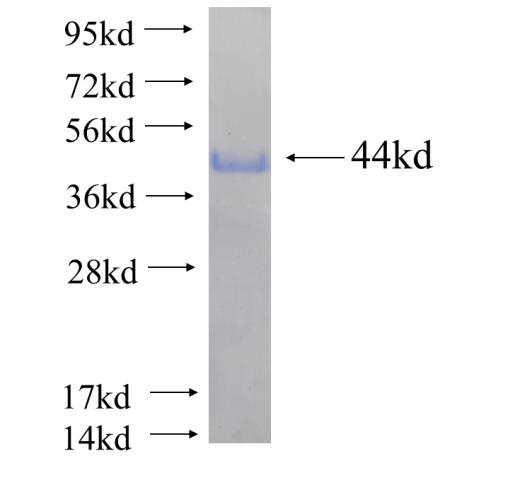-
Product Name
Human KCNA2 Recombinant protein (GST tag & His tag)
- Documents
-
Description
Voltage-gated potassium channel that mediates transmembrane potassium transport in excitable membranes, primarily in the brain and the central nervous system, but also in the cardiovascular system. Prevents aberrant action potential firing and regulates neuronal output. Forms tetrameric potassium-selective channels through which potassium ions pass in accordance with their electrochemical gradient. The channel alternates between opened and closed conformations in response to the voltage difference across the membrane (PubMed:19912772, PubMed:8495559, PubMed:11211111, PubMed:23769686). Can form functional homotetrameric channels and heterotetrameric channels that contain variable proportions of KCNA1, KCNA2, KCNA4, KCNA5, KCNA6, KCNA7, and possibly other family members as well; channel properties depend on the type of alpha subunits that are part of the channel (PubMed:8495559, PubMed:20220134). Channel properties are modulated by cytoplasmic beta subunits that regulate the subcellular location of the alpha subunits and promote rapid inactivation of delayed rectifier potassium channels. In vivo, membranes probably contain a mixture of heteromeric potassium channel complexes, making it difficult to assign currents observed in intact tissues to any particular potassium channel family member. Homotetrameric KCNA2 forms a delayed-rectifier potassium channel that opens in response to membrane depolarization, followed by slow spontaneous channel closure (PubMed:19912772, PubMed:23769686). In contrast, a heteromultimer formed by KCNA2 and KCNA4 shows rapid inactivation (PubMed:8495559). Regulates neuronal excitability and plays a role as pacemaker in the regulation of neuronal action potentials (By similarity). KCNA2-containing channels play a presynaptic role and prevent hyperexcitability and aberrant action potential firing (By similarity). Response to toxins that are selective for KCNA2-containing potassium channels suggests that in Purkinje cells, dendritic subthreshold KCNA2-containing potassium channels prevent random spontaneous calcium spikes, suppressing dendritic hyperexcitability without hindering the generation of somatic action potentials, and thereby play an important role in motor coordination (By similarity). Plays a role in the induction of long-term potentiation of neuron excitability in the CA3 layer of the hippocampus (By similarity). May function as down-stream effector for G protein-coupled receptors and inhibit GABAergic inputs to basolateral amygdala neurons (By similarity). May contribute to the regulation of neurotransmitter release, such as gamma-aminobutyric acid (GABA) (By similarity). Contributes to the regulation of the axonal release of the neurotransmitter dopamine (By similarity). Reduced KCNA2 expression plays a role in the perception of neuropathic pain after peripheral nerve injury, but not acute pain (By similarity). Plays a role in the regulation of the time spent in non-rapid eye movement (NREM) sleep (By similarity). {UniProtKB:P63141, UniProtKB:P63142, PubMed:11211111, PubMed:19912772, PubMed:20220134, PubMed:23769686, PubMed:8495559, }.
-
Protein name
Potassium voltage-gated channel subfamily A member 2
-
Uniprot ID
P16389
-
Gene Name
KCNA2
-
Source/Expression Host
E. coli
-
Expression Plasmid/cDNA
A DNA sequence encoding the human KCNA2 (XP_054192409.1) 1-163 aa was fused with the N-terminal GST tag and C-terminal 6His tag
-
Protein Species
Human
-
Activity
Not tested.
-
Validations

Recombinant human KCNA2 SDS-PAGE
Related Products / Services
Please note: All products are "FOR RESEARCH USE ONLY AND ARE NOT INTENDED FOR DIAGNOSTIC OR THERAPEUTIC USE"
